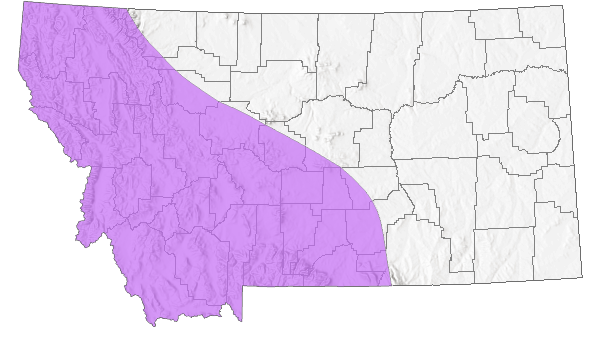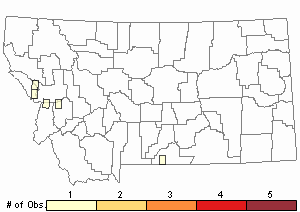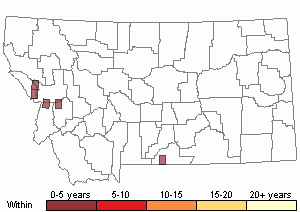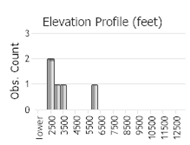View in other NatureServe Network Field Guides
NatureServe
Montana
Utah
Wyoming
Idaho
Wisconsin
British Columbia
South Carolina
Yukon
California
New York
Pacuvius Duskywing - Erynnis pacuvius
Native Species
Global Rank:
G5
State Rank:
S5
Agency Status
USFWS:
USFS:
BLM:
External Links
General Description
[From Ferris and Brown 1981; Scott 1986; Layberry et al. 1998; Opler and Wright 1999; Glassberg 2001; Pyle 2002] Forewing 1.6-1.7 cm (larger in second flight). Small, males lack tibial tufts on hindlegs. Uppersurface variable, uniform dark brown without white forewing apical spots to highly mottled blackish-brown with gray scaling, black patches and white spots on outer half of forewing; hindwing lighter brown with white fringe (nominate subspecies) or dark brown fringe (California and Pacific Northwest). Undersurface lighter brown, hindwing may show a submarginal row of pale spots.
Phenology
One flight in the north, May through June, June through July at high elevation; several flights in the south, April through September (Scott 1986). May to mid-July in one brood areas, March to October in two-brood areas (Glassberg 2001). June and July in Canada (Layberry et al. 1998), early May to early August in Colorado (Scott and Scott 1978; Scott and Epstein 1987), late April to late July in Oregon and Washington (Pyle 2002), early May to early August in Oregon (Warren 2005), early May to mid-July in British Columbia (Guppy and Shepard 2001).
Diagnostic Characteristics
Best determined in Montana by a combination of size, absence of male tibial tufts, uppersurface highly mottled blackish-brown with gray scaling, black patches and white spots on outer half of forewing; hindwing lighter brown with dark brown fringe. Undersurface lighter brown, hindwing may show a submarginal row of pale spots.
Species Range
Montana Range
Range Descriptions

 Native
Native
Range Comments
Southern British Columbia south through the Cascades and Sierra Nevada to northern Baja California, south in the Rocky Mountains from western Montana, Colorado to central Mexico (Scott 1986; Opler and Wright 1999; Glassberg 2001); up to about 2743 m elevation in the Rocky Mountain states (Ferris and Brown 1981), 1951 m to 2865 m elevation in Colorado (Scott and Scott 1978), 30 m to at least 2499 m elevation in Oregon (Warren 2005). In Montana, reported from at least 11 counties, mostly western but as far east as Yellowstone County (Kohler 1980; Stanford and Opler 1993; FLMNH Lepidopterists' Society database), mostly < 1525 m elevation. Rare to uncommon (Glassberg 2001).
Observations in Montana Natural Heritage Program Database
Number of Observations: 6
(Click on the following maps and charts to see full sized version)
Map Help and Descriptions
Relative Density

Recency



 (Observations spanning multiple months or years are excluded from time charts)
(Observations spanning multiple months or years are excluded from time charts)
Migration
Non-migratory.
Habitat
Chaparral, open conifer (ponderosa pine/Douglas fir) woodland, open deciduous woodland, shrubland, roadside ditches, riverbanks, montane clear-cuts (Brown 1957; Scott and Scott 1978; Ferris and Brown 1981; Scott 1986; Opler and Wright 1999; Glassberg 2001; Warren 2005). Habitat in Montana not described but probably similar.
Food Habits
Larval food plants are members of the Rhamnaceae, and include several species of Ceanothus (Brown 1957; Ferris and Brown 1981; Scott 1986, 1992, 2006; Layberry et al. 1998; Guppy andf Shepard 2001; Warren 2005; James and Nunnallee 2011). Adults feed on flower nectar (including Antennaria, Apocynum, Arctostaphylos, Astragalus, Ceanothus, Cerastium, Erysimum, Geranium, Hedysarum, Heterotheca, Jamesia, Lesquerella, Mertensia, Sedum, Senecio, Symphoricarpos, Taraxacum, Thlaspi) and mud (James and Nunnallee 2011; Scott 2014).
Reproductive Characteristics
Limited information. Females lay eggs singly on upper surface of small, new-growth host plant leaves, usually the basal half (Scott 1992; 2006; James and Nunnallee 2011). Eggs hatch in about 7 days, develop from L1 instar to L5 instar and pupation 38 days in captivity, but L5 instar typically overwinters (hibernates), adults eclose (emerge from pupae) in about 14 days in captivity (Scott 2006; James and Nunnallee 2011). Larvae solitary, build silk-tied tubular leaf nest, feed on host plant leaves, feed nocturnally, overwinter as L5 instar, pupate in final nest (Scott 2006; James and Nunnallee 2011). Males perch on hilltop rocks, vegetation < 1 m above ground throughout the day, patrol around host plants even on hillsides, awaiting passing females or actively seeking them (Scott 1975b, 1982, 1986; Warren 2005).
Stewardship Responsibility
References
- Literature Cited AboveLegend:
 View Online Publication
View Online Publication Ferris, C.D. and F.M. Brown (eds). 1981. Butterflies of the Rocky Mountains. Univ. of Oklahoma Press. Norman. 442 pp.
Ferris, C.D. and F.M. Brown (eds). 1981. Butterflies of the Rocky Mountains. Univ. of Oklahoma Press. Norman. 442 pp. Glassberg, J. 2001. Butterflies through Binoculars: A Field Guide to the Butterflies of Western North America. Oxford University Press.
Glassberg, J. 2001. Butterflies through Binoculars: A Field Guide to the Butterflies of Western North America. Oxford University Press. Guppy, C.S. and J.H. Shepard. 2001. Butterflies of British Columbia: including western Alberta, southern Yukon, the Alaska Panhandle, Washington, northern Oregon, northern Idaho, northwestern Montana. UBC Press (Vancouver, BC) and Royal British Columbia Museum (Victoria, BC). 414 pp.
Guppy, C.S. and J.H. Shepard. 2001. Butterflies of British Columbia: including western Alberta, southern Yukon, the Alaska Panhandle, Washington, northern Oregon, northern Idaho, northwestern Montana. UBC Press (Vancouver, BC) and Royal British Columbia Museum (Victoria, BC). 414 pp. James, D.G. and D. Nunnallee. 2011. Life histories of Cascadia butterflies. Corvallis, OR: Oregon State University Press. 447 p.
James, D.G. and D. Nunnallee. 2011. Life histories of Cascadia butterflies. Corvallis, OR: Oregon State University Press. 447 p. Kohler, S. 1980. Checklist of Montana Butterflies (Rhopalocera). Journal of the Lepidopterists' Society 34(1): 1-19.
Kohler, S. 1980. Checklist of Montana Butterflies (Rhopalocera). Journal of the Lepidopterists' Society 34(1): 1-19. Layberry, R.A., P.W. Hall, and J.D. LaFontaine. 1998. The Butterflies of Canada. University of Toronto Press. 280 pp. + color plates.
Layberry, R.A., P.W. Hall, and J.D. LaFontaine. 1998. The Butterflies of Canada. University of Toronto Press. 280 pp. + color plates. Opler, P.A. and A.B. Wright. 1999. A field guide to western butterflies. Second edition. Peterson Field Guides. Houghton Mifflin Company, Boston, Massachusetts. 540 pp.
Opler, P.A. and A.B. Wright. 1999. A field guide to western butterflies. Second edition. Peterson Field Guides. Houghton Mifflin Company, Boston, Massachusetts. 540 pp. Pyle, R.M. 2002. The butterflies of Cascadia: a field guide to all the species of Washington, Oregon, and surrounding territories. Seattle Audubon Society, Seattle, Washington. 420 pp.
Pyle, R.M. 2002. The butterflies of Cascadia: a field guide to all the species of Washington, Oregon, and surrounding territories. Seattle Audubon Society, Seattle, Washington. 420 pp. Scott, J.A. 1975b. Mate-locating behavior of western North American butterflies. Journal of Research on the Lepidoptera 14:1-40.
Scott, J.A. 1975b. Mate-locating behavior of western North American butterflies. Journal of Research on the Lepidoptera 14:1-40. Scott, J.A. 1982. Mate-locating behavior of western North American butterflies. II. New observations and morphological adaptations. Journal of Research on the Lepidoptera 21(3): 177-187.
Scott, J.A. 1982. Mate-locating behavior of western North American butterflies. II. New observations and morphological adaptations. Journal of Research on the Lepidoptera 21(3): 177-187. Scott, J.A. 1986. The butterflies of North America: a natural history and field guide. Stanford University Press, Stanford, California.
Scott, J.A. 1986. The butterflies of North America: a natural history and field guide. Stanford University Press, Stanford, California. Scott, J.A. 1992. Hostplant records for butterflies and skippers (mostly from Colorado) 1959-1992, with new life histories and notes on oviposition, immatures, and ecology. Papilio new series #6. 185 p.
Scott, J.A. 1992. Hostplant records for butterflies and skippers (mostly from Colorado) 1959-1992, with new life histories and notes on oviposition, immatures, and ecology. Papilio new series #6. 185 p. Scott, J.A. 2006. Butterfly hostplant records, 1992-2005, with a treatise on the evolution of Erynnis, and a note on new terminology for mate-locating behavior. Papilio new series #14. 74 p.
Scott, J.A. 2006. Butterfly hostplant records, 1992-2005, with a treatise on the evolution of Erynnis, and a note on new terminology for mate-locating behavior. Papilio new series #14. 74 p. Scott, J.A. 2014. Lepidoptera of North America 13. Flower visitation by Colorado butterflies (40,615 records) with a review of the literature on pollination of Colorado plants and butterfly attraction (Lepidoptera: Hersperioidea and Papilionoidea). Contributions of the C.P. Gillette Museum of Arthopod Diversity. Fort Collins, CO: Colorado State University. 190 p.
Scott, J.A. 2014. Lepidoptera of North America 13. Flower visitation by Colorado butterflies (40,615 records) with a review of the literature on pollination of Colorado plants and butterfly attraction (Lepidoptera: Hersperioidea and Papilionoidea). Contributions of the C.P. Gillette Museum of Arthopod Diversity. Fort Collins, CO: Colorado State University. 190 p. Scott, J.A. and G.R. Scott. 1978. Ecology and distribution of the butterflies of southern central Colorado. Journal of Research on the Lepidoptera 17(2): 73-128.
Scott, J.A. and G.R. Scott. 1978. Ecology and distribution of the butterflies of southern central Colorado. Journal of Research on the Lepidoptera 17(2): 73-128. Scott, J.A. and M.E. Epstein. 1987. Factors affecting phenology in a temperate insect community. American Midland Naturalist 117(1): 103-118.
Scott, J.A. and M.E. Epstein. 1987. Factors affecting phenology in a temperate insect community. American Midland Naturalist 117(1): 103-118. Stanford, R.E. and P.A. Opler. 1993. Atlas of western USA butterflies: including adjacent parts of Canada and Mexico. Unpubl. Report. Denver and Fort Collins, Colorado 275 pp.
Stanford, R.E. and P.A. Opler. 1993. Atlas of western USA butterflies: including adjacent parts of Canada and Mexico. Unpubl. Report. Denver and Fort Collins, Colorado 275 pp. Warren, A.D. 2005. Lepidoptera of North America 6: Butterflies of Oregon, their taxonomy, distribution, and biology. Contributions of the C. P. Gillette Museum of Arthropod Diversity, Colorado State University. Fort Collins, Colorado. 406 pp.
Warren, A.D. 2005. Lepidoptera of North America 6: Butterflies of Oregon, their taxonomy, distribution, and biology. Contributions of the C. P. Gillette Museum of Arthropod Diversity, Colorado State University. Fort Collins, Colorado. 406 pp.
- Additional ReferencesLegend:
 View Online Publication
View Online Publication
Do you know of a citation we're missing? Allen, T.J., J.P. Brock, and J. Glassberg. 2005. Caterpillars in the field and garden: a field guide to the butterfly caterpillars of North America. Oxford University Press.
Allen, T.J., J.P. Brock, and J. Glassberg. 2005. Caterpillars in the field and garden: a field guide to the butterfly caterpillars of North America. Oxford University Press. Brock, J.P. and K. Kaufman. 2003. Kaufman Field Guide to Butterflies of North America. Houghton Mifflin Company, New York, NY 284 pp.
Brock, J.P. and K. Kaufman. 2003. Kaufman Field Guide to Butterflies of North America. Houghton Mifflin Company, New York, NY 284 pp. Forister, M.L., C.A. Halsch, C.C. Nice, J.A. Fordyce, T.E. Dilts, J.C. Oliver, K.L. Prudic, A.M. Shapiro, J.K. Wilson, J. Glassberg. 2021. Fewer butterflies seen by community scientists across the warming and drying landscapes of the American West. Science 371:1042-1045.
Forister, M.L., C.A. Halsch, C.C. Nice, J.A. Fordyce, T.E. Dilts, J.C. Oliver, K.L. Prudic, A.M. Shapiro, J.K. Wilson, J. Glassberg. 2021. Fewer butterflies seen by community scientists across the warming and drying landscapes of the American West. Science 371:1042-1045.
- Web Search Engines for Articles on "Pacuvius Duskywing"
- Additional Sources of Information Related to "Insects"





